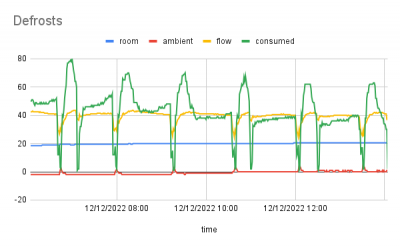I found my Daikin unit coped well with the recent cold spell, even when we had freezing fog the defrost cycles seemed very quick and didn't cause much interruption to the operation. I didn't manage to observe for long enough to time how frequent they were - not sure if there is any way to look back and see energy data. The screen only shows energy use in bar graph format with a 2 hour resolution.
Posted by: @bataltoonce you get below -5 there is no moisture in the air so you get substantially less defrosting - nothing to freeze. I used to live in Finland for a bit and -10 feels better than -2.
Correct, I was going to include that but it complicated the post more than I wanted, and furthermore at -5 and below the main problem is the heat pump's output dropping through the floor.
Midea 14kW (for now...) ASHP heating both building and DHW
Posted by: @cathoderayPosted by: @bataltoonce you get below -5 there is no moisture in the air so you get substantially less defrosting - nothing to freeze. I used to live in Finland for a bit and -10 feels better than -2.
Correct, I was going to include that but it complicated the post more than I wanted, and furthermore at -5 and below the main problem is the heat pump's output dropping through the floor.
Not if you have a GSHP, which I believe is often the case in the Scandinavian countries.
Hi
We don’t have adjustable flow temperatures. Either not available to the user or because it’s air to air I don’t know. It seems if the room is more than about 10 degrees off the requested temperature the refrigerant flow (copper of the pipework qt least) is about 45-55C through the 50m of pipework all mounted outside and emitting at 20C through insulation. Over the really cold spat the temps in some rooms settled eventually at 14C so we had a maxed out inverter the whole time, when heating. It would run hot for about an hour. Defrost for 15 min. Take another 15min to 45min warming up the inverter before running for another hour. The defrost on air to air literally runs as an air conditioner blowing cold air so nowhere warm in the house although no one at risk in the house during this experimentation. The more I look at this setup, it’s location/humidity, it’s underpowered, it’s always high flow temp, it’s outside heat loss etc the more I think I would have done differently if I was the qualified one installing but at the moment I’m still waiting on resolution some 6 months later.
Thanks
Fujitsu AOYG45LBLA6 feeding 4x ASYG09LMCE and 2x ASYG12LMCE but all being a big paperweight and powered down since summer as it can’t generate enough heat in the 20+kW heat loss early 1800s home.
Posted by: @derek-mNot if you have a GSHP, which I believe is often the case in the Scandinavian countries.
Good point about GSHPs. It would still be interesting to know how other countries deal with ASHP frosting. Maybe they adopt @batalto's solution, choose to live where it is -10! But even in Finland and other cold places, there must be times in the year when they are in frosting temps.
The Midea seems fairly quick in it's defrost cycles, and when I've seen one happen, there isn't much of a dip in the secondary circuit temperature. I wonder if that may be a hidden benefit of the plate heat exchanger? If the direction of flow in the primary circuit reverses - not sure whether it does or not, but I think it must do, because the LWT goes below the RWT - then the PHE is the wrong way round, parallel flow rather than contraflow, and so it will be less efficient, and the secondary circuit will lose less heat back to the primary circuit. The heat pump then only has to heat the primary circuit during recovery.
Midea 14kW (for now...) ASHP heating both building and DHW
Posted by: @cathoderayPosted by: @derek-mNot if you have a GSHP, which I believe is often the case in the Scandinavian countries.
Good point about GSHPs. It would still be interesting to know how other countries deal with ASHP frosting. Maybe they adopt @batalto's solution, choose to live where it is -10! But even in Finland and other cold places, there must be times in the year when they are in frosting temps.
The Midea seems fairly quick in it's defrost cycles, and when I've seen one happen, there isn't much of a dip in the secondary circuit temperature. I wonder if that may be a hidden benefit of the plate heat exchanger? If the direction of flow in the primary circuit reverses - not sure whether it does or not, but I think it must do, because the LWT goes below the RWT - then the PHE is the wrong way round, parallel flow rather than contraflow, and so it will be less efficient, and the secondary circuit will lose less heat back to the primary circuit. The heat pump then only has to heat the primary circuit during recovery.
The primary water flow does not change direction, it is the refrigerant gas flow inside the heat pump which changes direction.
Posted by: @derek-mThe primary water flow does not change direction, it is the refrigerant gas flow inside the heat pump which changes direction.
That's what I thought, it's the heat pump that 'inverts' to become a fridge, and uses the warm exhaust gas from the fridge to do the defrosting (put like this, it does shows it is a somewhat bizarre thing to be doing in cold weather...). But I needed to get my head round what the primary circuit does, and yes, now I have got it: the 'fridge' takes the heat from the returning water which is still going round the circuit the same normal way, and as a result, the leaving water has a lower temp than the returning water.
But that still leaves the question of whether the PHE somehow provides some protection against heat being lost from the secondary circuit. Based on only a few observations, I could see the LWT falling and then rising over a period of a few minutes, but a nearby and not particularly large rad didn't appear to change temp to the same extent, if at all. The reason for asking this rather obscure question is if it does provide any meaningful protection, then it becomes a possible argument in favour of PHEs.
Midea 14kW (for now...) ASHP heating both building and DHW
Posted by: @cathoderayPosted by: @derek-mThe primary water flow does not change direction, it is the refrigerant gas flow inside the heat pump which changes direction.
That's what I thought, it's the heat pump that 'inverts' to become a fridge, and uses the warm exhaust gas from the fridge to do the defrosting (put like this, it does shows it is a somewhat bizarre thing to be doing in cold weather...). But I needed to get my head round what the primary circuit does, and yes, now I have got it: the 'fridge' takes the heat from the returning water which is still going round the circuit the same normal way, and as a result, the leaving water has a lower temp than the returning water.
But that still leaves the question of whether the PHE somehow provides some protection against heat being lost from the secondary circuit. Based on only a few observations, I could see the LWT falling and then rising over a period of a few minutes, but a nearby and not particularly large rad didn't appear to change temp to the same extent, if at all. The reason for asking this rather obscure question is if it does provide any meaningful protection, then it becomes a possible argument in favour of PHEs.
I doubt that having a PHE will make much if any difference to the defrost cycle.
The temperature change at the flow and return temperature sensors will be much more noticeable, because all the water flow is going through the same pipes at that point. This water flow is shared over the number of radiators within the system, so the temperature change at the radiators will be much smaller.
The same process will take place whether a PHE is installed or not.
Hi
So on a air to air a defrost cycle actively blows cold 10-15C air into the room (for at least 7 minutes typically 10-20min) but are you saying an air to water during defrost the radiators in the home hardly change in temperature at all?
Thanks
Fujitsu AOYG45LBLA6 feeding 4x ASYG09LMCE and 2x ASYG12LMCE but all being a big paperweight and powered down since summer as it can’t generate enough heat in the 20+kW heat loss early 1800s home.
On my system, defrosts definitely lower the flow temp, both on the monitoring and the rads getting noticeably cooler. Does it make the house cooler? Almost certainly because the average flow temp shown in the graph below is about 3 deg lower that the WC target. Interestingly, defrosting neither increases power used nor decreases the COP. It would have done both had I maintained the WC flow temp by bumping up the curve.
Hi
Thank you for this. I see the flow temp drop and the radiators must get colder but the room temps don’t seem to drop. Does it reduce the flow or anything to compensate?
Thanks
Fujitsu AOYG45LBLA6 feeding 4x ASYG09LMCE and 2x ASYG12LMCE but all being a big paperweight and powered down since summer as it can’t generate enough heat in the 20+kW heat loss early 1800s home.
Posted by: @huwsyHi
Thank you for this. I see the flow temp drop and the radiators must get colder but the room temps don’t seem to drop. Does it reduce the flow or anything to compensate?
Thanks
It is all to do with the amount of stored heat energy and its location. A litre of water contains approximately 3500 times more energy than a litre of air. When an ASHP carries out a defrost cycle, it uses electrical energy to drive the compressor and heat the refrigerant gas, along with heat energy from the water, or in your case air, to provide the heat necessary to melt the ice on the evaporator.
- 26 Forums
- 2,152 Topics
- 47.2 K Posts
- 23 Online
- 5,671 Members
Join Us!
Podcast Picks
Latest Posts
-
RE: Heat Pump SCOPs – The Truth Might Not Be What You Think
A heat pump is only as good as the desired room tempera...
By DREI , 5 minutes ago
-
RE: Flexi-Orb Heat Pump Scheme: A Game-Changer for the UK's Heat Pump Industry
As someone who has suffered from a Heat Pump installati...
By DREI , 44 minutes ago
-
RE: A Customer's Lessons Learnt from a Heat Pump Installation in a Large House
@drei Based on your recent posts, I am wondering what y...
By JamesPa , 2 hours ago
-
RE: Solar Power Output – Let’s Compare Generation Figures
1040kw Even beat June and July. Great month.
By Andris , 2 hours ago
-
RE: Midea ASHP – how to set weather compensation
I'm guessing these are the mcs defaults which are likel...
By JamesPa , 2 hours ago
-
RE: New Vaillant aroTherm Plus in black - When will it come to the UK?
Hope they know what they're doing regarding paint types...
By PatrickVito , 3 hours ago
-

RE: What crazy nonsense are inverter limits and why are they imposed?
I’ve also got a dual fuel Rangemaster. We originally ha...
By Majordennisbloodnok , 5 hours ago
-

RE: Octopus tariffs - a quick comparison
@tim441 I’d agree wholeheartedly with that, with 2 x Po...
By Toodles , 6 hours ago
-
RE: Electricity price predictions
@bontwoody Maybe one for @editor to consider whether a ...
By ChandyKris , 12 hours ago
-
RE: is a home battery without an EV worth it?
You would think, but when I had my Powerwall 3 installe...
By Old_Scientist , 12 hours ago
-
@mars That response surely deserves a nomination for Tu...
By JamesPa , 1 day ago
-
Specifying batteries, pv solar etc using ChatGPT
I thought I'd try to use ChatGPT to specify my requirem...
By Tim441 , 1 day ago
-

RE: Ecodan & MelCloud scheduling
When I interviewed Mitsubishi Electric at Installer ear...
By Mars , 1 day ago
-

RE: Rodents! A word of warning for heat pump owners
@lucia One look at that protection and the rodents will...
By Toodles , 1 day ago
-

What is the Heat Geek Guarantee?
We regularly hear from homeowners who are researching i...
By Mars , 2 days ago
-

RE: Help me keep the faith with my air source heat pump installation
@adamk, interesting point. I’ve not focused much on Hea...
By Mars , 2 days ago
-
Intelligent Octopus Flux (IOF) Review
I promised @toodles that I would provide an update and ...
By Old_Scientist , 2 days ago
-

RE: Who's your electricity provider and what's your tariff?
I am pleased to see the change. We definitely need t...
By Jeff , 3 days ago
-

RE: How Do I Know When the Hot Water Has Run Out?
@transparent that is a very interesting suggestion, tha...
By GrahamF , 4 days ago






